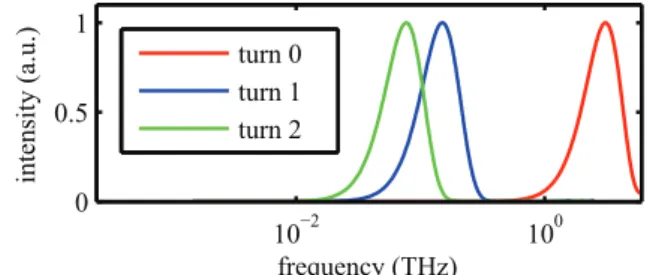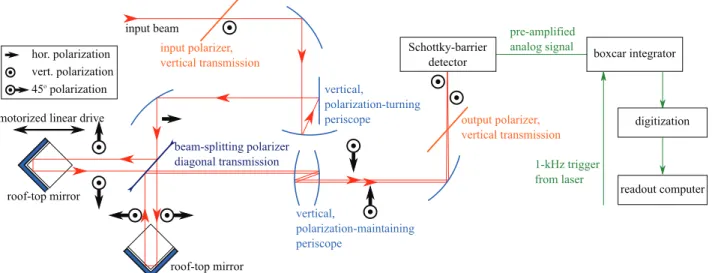TIME-RESOLVED SPECTRAL OBSERVATION OF COHERENT THz PULSES AT DELTA ∗
C. Mai † , P. Ungelenk, F. H. Bahnsen, M. Bolsinger, F. Götz, S. Hilbrich, M. Höner, M. A. Jebramcik, S. Khan, N. M. Lockmann, A. Meyer auf der Heide, R. Molo,
R. Niemczyk, G. Shayeganrad, M. Suski, D. Zimmermann,
Center for Synchrotron Radiation (DELTA), TU Dortmund University, 44227 Dortmund, Germany Abstract
Coherent THz pulses induced by a laser-electron interac- tion are routinely produced and observed at DELTA, a 1.5- GeV synchrotron light source operated by the TU Dortmund University. At a dedicated THz beamline, measurements using a Fourier-transform spectrometer have been performed between 1 THz and 7 THz. Recently, an ultrafast Schottky- diode detector and a novel polarizing Fourier-transform spec- trometer were installed, which enable turn-by-turn-resolved spectral measurements in the frequency range below 1 THz.
The commissioning results of the new spectrometer and simulations are presented.
INTRODUCTION
DELTA, a 1.5-GeV electron storage ring with a circumfer- ence of 115.2 m and a revolution frequency of 2.6 MHz, is a synchrotron light source operated by the TU Dortmund uni- versity. A short-pulse source using the coherent harmonic generation (CHG) [1, 2] principle for the generation of ultra- short VUV and THz pulses has been constructed since 2011.
A 40-fs Ti:sapphire laser system operating at 1-kHz repeti- tion rate with a pulse energy of 8 mJ is used in an interaction with a short slice of an electron bunch during the transition through the electromagnetic undulator U250. The undulator is divided into three parts, the modulator (7 periods), the chicane (3 periods) and the radiator (7 periods). A sinu- soidal energy modulation is imprinted onto the center of the electron bunch. The energy modulation is converted into a density modulation by the chicane and hence microbunches are formed which emit coherent VUV radiation at harmon- ics of the laser wavelength in the radiator. The longitudinal electron distribution further changes in the subsequent mag- netic lattice due to energy-dependent path lengths in the bending magnets. In consequence, a sub-picosecond dip in the longitudinal density is created, giving rise to emission of coherent THz radiation. This radiation is extracted at a dedicated THz beamline (BL5a) [3, 4]. The THz beam is guided over the radiation protection wall to the experiments by in-vacuum toroidal aluminium mirrors. The THz labo- ratory is equipped with different detectors, such as an InSb hot-electron bolometer, an ultrafast detector (<17 ps FWHM response time) based on the high-temperature superconduc- tor YBa
2Cu
3O
7(YBCO) [5, 6], an ultrafast Schottky-barrier diode detector and a Fourier-transform spectrometer with
∗Work supported by the BMBF (05K13PEC), the DFG (INST 212/236-1) and the state of NRW.
†carsten.mai@tu-dortmund.de


